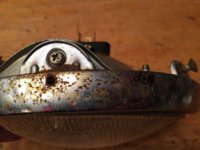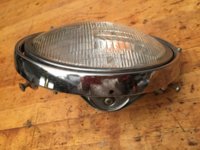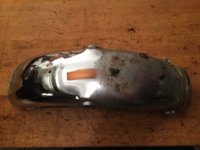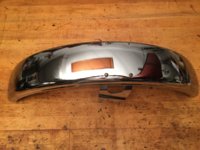In a prior post MaxPete had asked the purpose of using aluminum foil in cleaning chrome pieces with Windex and foil. This is a method I had seen used on the forum by gggGary and others and began using it myself. The reason foil is used lays more in the nature of iron (and therefor rust) than in chrome. It is mostly the rust pitting on the chrome that the aluminum attacks.
Why does it work? Short answer; oxygen loves aluminum more than iron.
I want to geek out and expand on this a little bit (or as much as dusty old memories from chemistry class will allow).
There is a symmetry to chemical reactions; a give and take. These exchanges are called “Oxidation-Reduction” reactions (Redox). It is a kind of balance sheet. If one substance is oxidized, there must be something else reduced. A quid pro quo. Redox reactions don’t always have oxygen in the reaction; but they often do, and for our purposes we will just think in those terms. We can see this as a handoff of oxygen between elements, in our case, iron and aluminum. The element or chemical that grabs the oxygen is oxidized. The substance it was stolen from is reduced.
Now to the chrome on your motorcycle. Some of the chrome is pitted with rust. Oxygen, with the help of moisture, has gotten to the iron/steel beneath the chrome and has oxidized it, producing iron oxide (rust).
4Fe (iron)+ 3O2 (oxygen) = 2Fe2O3 (iron oxide i.e. rust)
In cleaning the chrome, we want to reduce the rust by stripping off the oxygen from the iron. To do this we need some moisture. Plain water will work, or a weak base (ammonia/Windex) or a weak acid (vinegar). We also need something that wants oxygen more than the iron. Aluminum is a great candidate. It loves to be oxidize. So, in the presence of water (or ammonia or vinegar etc.), iron oxide is reduced to iron while aluminum is oxidized to aluminum oxide.
Fe2O3 (rust) + 2Al (aluminum) = Al2O3 (aluminum oxide) + 2Fe (iron)
Windex or ammonia is used to speed up the reaction and, I believe, will leave any residue slightly basic and less susceptible to further oxidation.
That is the nuts and bolts of using the aluminum foil.
Now that the rust has been removed, there are still pin point spots where the chrome plating no longer protects the iron/steel underneath. If left to air and moisture, these areas would continue to rust. The next step is to use some polish or wax to seal the iron and chrome from additional pitting. I am not going for museum quality work and feel Blue Magic has enough polish/wax in it to protect the chrome and give a good look. But there are plenty of polishes and protective coatings that will seal the iron from the atmosphere, prevent further pitting and have your chrome glistening.


headlight before using the Windex and foil, and the same area afterwards (with still more work to do)


Rear fender half cleaned, half not touched. Front fender cleaned with Windex/foil finished off with Blue Magic.
Why does it work? Short answer; oxygen loves aluminum more than iron.
I want to geek out and expand on this a little bit (or as much as dusty old memories from chemistry class will allow).
There is a symmetry to chemical reactions; a give and take. These exchanges are called “Oxidation-Reduction” reactions (Redox). It is a kind of balance sheet. If one substance is oxidized, there must be something else reduced. A quid pro quo. Redox reactions don’t always have oxygen in the reaction; but they often do, and for our purposes we will just think in those terms. We can see this as a handoff of oxygen between elements, in our case, iron and aluminum. The element or chemical that grabs the oxygen is oxidized. The substance it was stolen from is reduced.
Now to the chrome on your motorcycle. Some of the chrome is pitted with rust. Oxygen, with the help of moisture, has gotten to the iron/steel beneath the chrome and has oxidized it, producing iron oxide (rust).
4Fe (iron)+ 3O2 (oxygen) = 2Fe2O3 (iron oxide i.e. rust)
In cleaning the chrome, we want to reduce the rust by stripping off the oxygen from the iron. To do this we need some moisture. Plain water will work, or a weak base (ammonia/Windex) or a weak acid (vinegar). We also need something that wants oxygen more than the iron. Aluminum is a great candidate. It loves to be oxidize. So, in the presence of water (or ammonia or vinegar etc.), iron oxide is reduced to iron while aluminum is oxidized to aluminum oxide.
Fe2O3 (rust) + 2Al (aluminum) = Al2O3 (aluminum oxide) + 2Fe (iron)
Windex or ammonia is used to speed up the reaction and, I believe, will leave any residue slightly basic and less susceptible to further oxidation.
That is the nuts and bolts of using the aluminum foil.
Now that the rust has been removed, there are still pin point spots where the chrome plating no longer protects the iron/steel underneath. If left to air and moisture, these areas would continue to rust. The next step is to use some polish or wax to seal the iron and chrome from additional pitting. I am not going for museum quality work and feel Blue Magic has enough polish/wax in it to protect the chrome and give a good look. But there are plenty of polishes and protective coatings that will seal the iron from the atmosphere, prevent further pitting and have your chrome glistening.


headlight before using the Windex and foil, and the same area afterwards (with still more work to do)


Rear fender half cleaned, half not touched. Front fender cleaned with Windex/foil finished off with Blue Magic.
